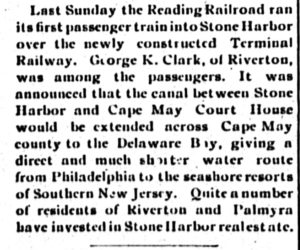
With the return of Daylight Savings Time and warmer temps, our thoughts wander to visits to the Jersey Shore.
But which one? LBI, Avalon, Ocean City, and Wildwood are all favorites, but Riverton folks have been going to Stone Harbor since its early days.
Postcard collector and local history buff Harlan B. Radford Jr. elaborates below on a classic landmark of that resort – the Water Works.
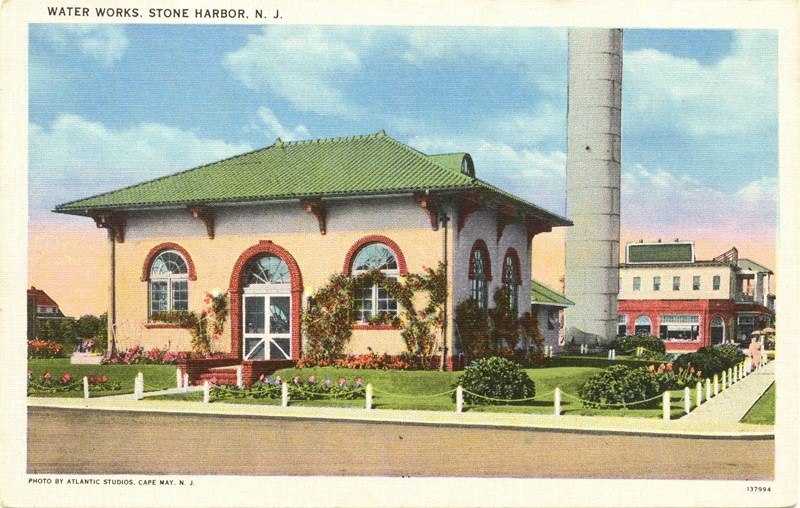
by Harlan B. Radford Jr.
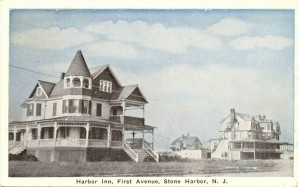
The Risley Brothers, developers of Stone Harbor, recognized that if their enterprise was to succeed, it needed an ample supply of clean and safe water. The city water supply soon replaced private wells such as the one that served the Harbor Inn over near 80th Street with gasoline engine-powered water pumps.
In the winter of 1908-1909, the Risley Brothers completed an artesian waterworks system at 96th Street and Second Avenue with a well that tunneled to a depth of 856 feet and accessed a geological water-bearing formation known as the Kirkwood Aquifer. The 10-foot diameter vertical standpipe on that first pumping station stood 100 feet high and held 60,000 gallons of water.
The following selection of vintage images and information will highlight key moments in Stone Harbor’s waterworks history.
Note the circular stairs ascending to the top of the standpipe in these two postcards that depict the newly completed waterworks, but from two different vantage points.
Harry S. Parks, the engineer, took the photo on the left of this two-part image which shows the interior of the Stone Harbor water pump house that went into service in 1909 or 1910.
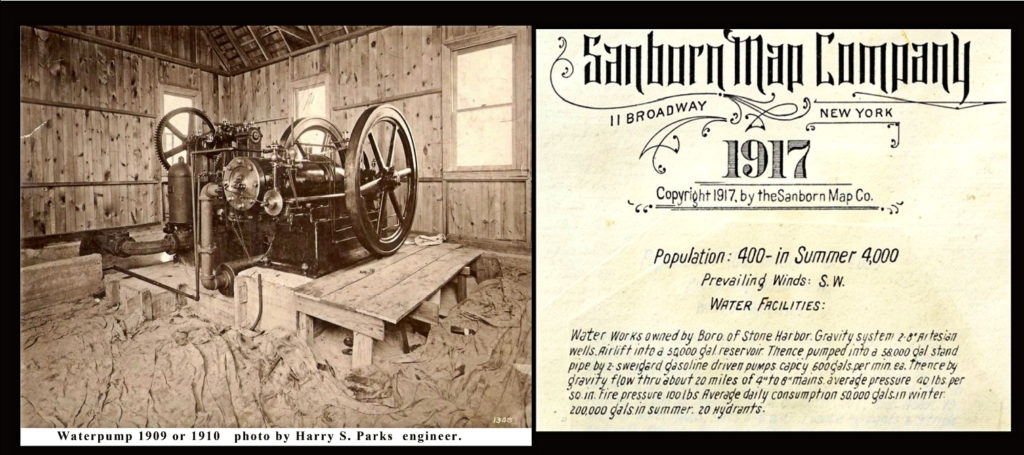
On the right, a scan of a section of the 1917 Sanborn Insurance Map of Stone Harbor details the specifications of the water facilities.
Sanborn Map Company / 11 Broadway / New York / 1917 / Copyright 1917, by the Sanborn Map Co. Population: 400- in Summer 4,000 / Prevailing Winds: S.W. / WATER FACILITIES: Water Works owned by Boro. of Stone Harbor. Gravity system 2-8″ Artesian wells. Airlift into a 50,000 gal. reservoir. Thence pumped into a 58,000 gal. stand pipe by 2-sweigard gasoline driven pumps. capcy 600gals. per min. ea. Thence by gravity flow thru about 20 miles of 4″ to 8″ mains. average pressure 40 lbs. per sq. in. Fire pressure 100 lbs. Average daily consumption 50,000 gals. in winter: 200,000 gals. in summer. 20 hydrants.
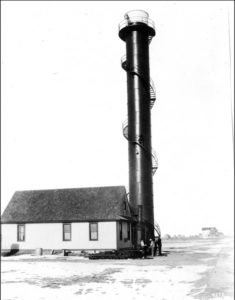
A photo from that period shows the pump house and standpipe and reveals five workers, three of whom stand at the base of the standpipe, another worker ascends the circular stairs about halfway up, and a fifth workman is at the very top level of the standpipe. At least 10 to 12 large houses loom in the distant background in this early north-facing view.
This rare antique ocean-facing photo below features the new water works and shows a Pennsylvania Railroad train parked along Second Avenue.
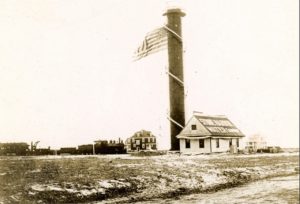
It is possibly a work train that appears to be carrying some freight or construction materials, has a lifting crane for loading and unloading, and has at least one attached passenger or personnel car.
Also, the pump house roof now boldly displays four words in large white letters – “STONE HARBOR WATER Company.” Festive patriotic bunting frames the pump house and traces the entire spiral staircase, and a huge American flag is flapping in a strong breeze at the top of the standpipe in this spectacular photo taken around 1910.
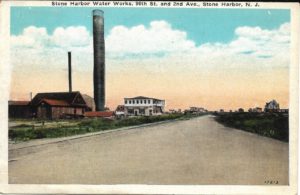
This early c1920s view captures the Stone Harbor water works and Diller’s Store on 95th Street, looking north along the expansive Second Avenue. Several cottages and residential homes in the distance line First Avenue.
By 1924, increased demand for a safe and dependable water supply for the fast-growing community required the construction of another pumping station and newly installed pumps at the same 96th Street location and a new, second well drilled to a depth of 890 feet.
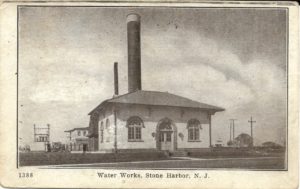
Postmarked in 1925, just one year after the completion of the new pumping station, this black and white postcard is one of the earliest known views of the water works with the standpipe behind the new pumping station. This second pumping station is Stone Harbor’s oldest public building.
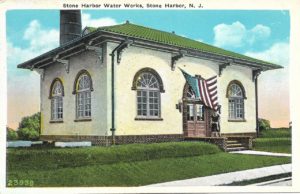
The Water Works’ distinctive Mediterranean style architecture and its classic tile roof made the pumping station a well-recognized, even iconic, Stone Harbor landmark. A large American flag adorns the front-door entrance to this building in this vivid color postcard.
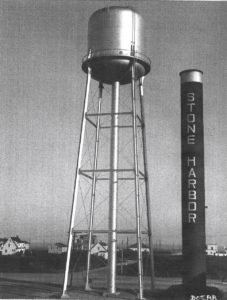
Sometime during the 1940s, the original standpipe or water tower proved insufficient, and a replacement tower with a capacity of 150,000 gallons was approved and built.
This new second water tower had a very different silhouette and consisted of a large holding tank perched atop a four-legged structure with a large water pipe running from the ground up. A third well drilled at 92nd Street and Second Avenue in 1949 to a depth of 878 feet added additional capacity.
Until the original tower on the right was dismantled and removed, the new, larger 1940s water tower and its 1909 predecessor stood side by side for several months.
The following three postcards, provided in a chronological sequence, depict views of the 1940s replacement tower taken over some 10-15 years.
Captured in either 1946 or 1947 from an upper floor of the Shelter Haven Hotel, the real photo postcard view at left shows some undeveloped parcels of land evident along the 96th Street business district. The linen postcard was mailed in 1955, and the chrome postcard was sent in 1961. During this time, a fourth freshwater well was dug in 1955 to a depth of 965 feet at 101st Street and Second Avenue.
Sometime in the early 1960s, the borough changed the paint color of the water tower from a darker blue-gray hue to a less dramatic light green color, as these two more modern chrome postcards show.
Grassy islands with lush flowers run along the middle of Second Avenue, with many still recognizable and notable public buildings in the foreground. The water tower is prominent in the background of the photo of the municipal tennis courts.
These last two continental-size modern-era postcards picture the latest and current water tower version that was constructed in 1978. The elevated single-column hydropillar design water tank stands 133 feet high and has a 500,000-gallon capacity.
This water tower structure features a vertical fluted support column substantially different in size and basic appearance from its two predecessors. Presently, four wells supply water for Stone Harbor, which is then aerated and disinfected before being distributed through approximately 150,000 feet of pipe to more than 2,900 customers.
For more than a century, Stone Harbor has kept pace with the ongoing need to provide its residents with dependable, safe drinking water. Besides serving their practical use, the three different water towers have also provided elevated vantage points that have yielded some excellent photographic images of the changing face of the downtown business district over time.
*Stone Harbor: One Hundred Years of the Seashore At Its Best, Copyright Exit Zero Press – First Edition 2014 – Exit Zero Press, 109 Sunset Boulevard, Suite D, Cape May, N.J. 08204
Harlan Radford also contributes to the Stone Harbor Museum website and Facebook page.

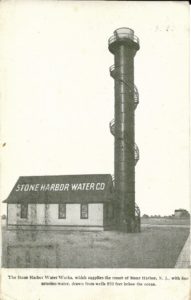
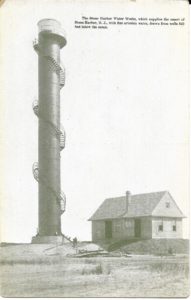
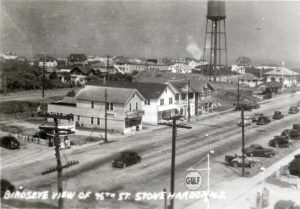
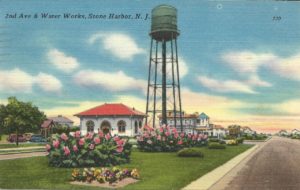
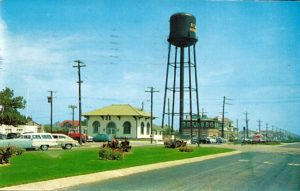
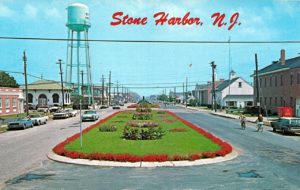
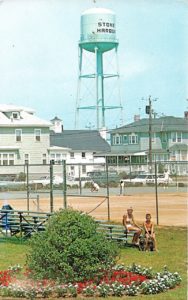
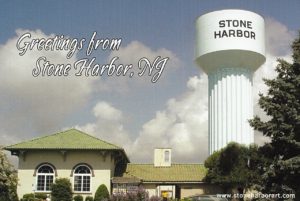
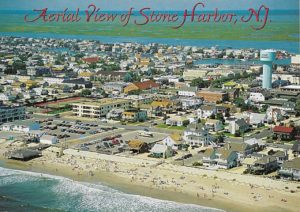
Outstanding John
Thanks for visiting again, Norm. I have my buddy Harlan to thank for this one. I am so gratified that you, John Savage, and other “regulars” have met up here and reminisced, making the Stone Harbor page the most visited page on our website. A close runner-up is Harlan’s series of essays on Camp Lenape: https://rivertonhistory.com/tag/camp-lenape/
Good work John! You run a very professional looking web page. Thank for all your efforts.